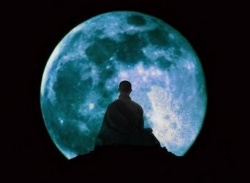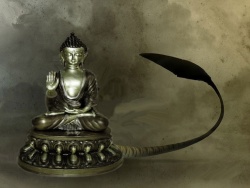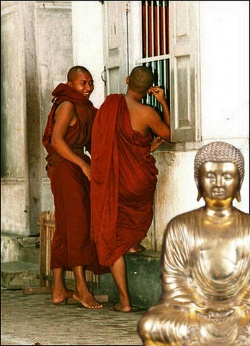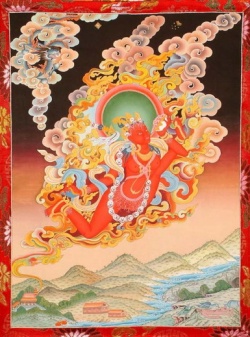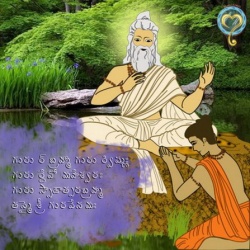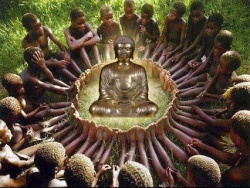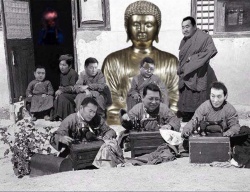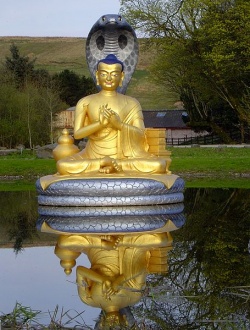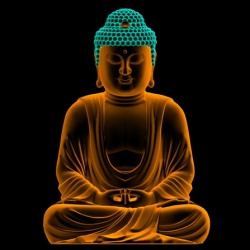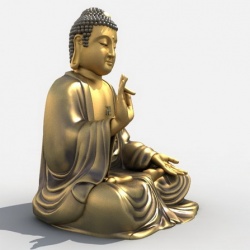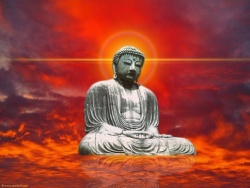Śūnyatā
Śūnyatā, (Sanskrit, also Shunyata; Pali: suññatā), is a Buddhist term that is translated into English as emptiness, openness, thusness, etc. Śūnyatā refers to the absence of inherent existence in all phenomena, and it is complementary to the Buddhist concepts of no-self (Pāli: Anatta, Sanskrit: Anātman) and Dependent origination.
The exact definition of emptiness varies from one Buddhist tradition to another.
Etymology
Over time, many different philosophical schools or tenet-systems (Sanskrit: siddhānta) have developed within Buddhism in an effort to explain the exact philosophical meaning of emptiness.
After The Buddha, emptiness was further developed by Nāgārjuna and the Mādhyamaka school, an early Mahāyāna school.
Emptiness ("positively" interpreted) is also an important element of the Buddha nature literature, which played a formative role in the evolution of subsequent Mahāyāna doctrine and practice.
Pali Canon
The Suñña Sutta, part of the Pāli canon, relates that the Monk Ānanda, Buddha's attendant asked,:
It is said that the world is empty, the world is empty, lord. In what respect is it said that the world is empty?"
The Buddha replied, "Insofar as it is empty of a self or of anything pertaining to a self: Thus it is said, Ānanda, that the world is empty.In S IV.295, it is explained that a Bhikkhu can experience a deathlike contemplation in which perception and feeling cease. When he emerges from this state, he recounts three types of "contact" (phasso)
- "emptiness" (suññato),
- "signless" (animitto),
- "undirected" (appaṇihito).
The meaning of emptiness as contemplated here is explained at M I.297 and S IV.296-97 as the "emancipation of the mind by emptiness" (suññatā cetovimutti) being consequent upon the realization that "this world is empty of self or anything pertaining to self" (suññam idaṃ attena vā attaniyena vā).
The term "emptiness" (suññatā) is also used in two suttas in the Majjhima Nikāya, in the context of a progression of mental states. The texts refer to each state's emptiness of the one below.
Prajna-paramita Sutras
- See also: Perfection of Wisdom
The Prajnaparamita (Perfection of Wisdom) Sutras taught that all entities, including dharmas, are only conceptual existents or constructs.
Though we perceive a world of concrete and discrete objects, these objects are "empty" of the identity imputed by their designated labels.
The Heart Sutra, a text from the prajnaparamita-sutras, articulates this in the following saying in which the Five Skandhas are said to be "empty":
Mādhyamaka
- See also: Madhyamaka
Mādhyamaka is a Mahāyāna Buddhist school of philosophy. In Madhyamaka, to say that an object is "empty" is synonymous with saying that it is dependently originated.Madhyamaka states that impermanent collections of causes and conditions are designated by mere conceptual labels.
This also applies to the principle of causality itself, since everything is dependently originated.
If unaware of this, things may seem to arise as existents, remain for a time and then subsequently perish. In actuality, dependently originated phenomena do not arise as existents in the first place. Thus both existence and nihilism are ruled out.
Nagarjuna
Madhyamika is retroactively seen as being founded by the Monk Nāgārjuna.
Nāgārjuna's goal was to refute the essentialism of Abhidharma. His best-known work is the Mūlamadhyamakakārikā, in which he used the reductio ad absurdum to show the non-substantiality of the perceived world.Nāgārjuna equates emptiness with Dependent origination
- On the basis of The Buddha's view that all experienced phenomena (Dharma) are "dependently arisen" (pratitya-samutpanna), Nagarjuna insisted that such phenomena are empty (sunya). This did not mean that they are not experienced and, therefore, non-existent; only that they are devoid of a permanent and eternal substance (Svabhava). Since they are experienced elements of existence, they are not mere names (prjnapti).
In his analysis, any enduring essential nature would prevent the process of Dependent origination, or any kind of origination at all.
For things would simply always have been, and will always continue to be, without any change.
In doing so, he restores the Middle Way of The Buddha, which had become influenced by absolute tendencies
- Utilizing The Buddha's theory of "Dependent arising" (pratitya-samutpanna) Nagarjuna demonstrated the futility of these metaphysical speculations.
His method of dealing with such metaphysics is referred to as a "Middle Way"(madhyama pratipad).
It is the Middle Way that avoided the substantialism of the Sarvastivadins as well as the nominalism of the Sautrantikas.
Prasaṅgika
- See also: Prasaṅgika
The Prasangika is a sub-school of the Madhyamaka. The name is derived from prasanga, or reductio ad absurdum arguments, rather than svatantra-anumana, or independent syllogisms.
Buddhapalita (470–550), a commentator on the works of Nāgārjuna and Aryadeva, was a great master and exponent of the Prasangika system. Buddhapālita notes:
- It is not that we claim non-existence, we merely remove claims for existing existents.
Candrakīrti states:
- Since relativity is not objectively created, those who, through this reasoning, accept dependent things as resembling the moon in water and reflections in a mirror, understand them as neither objectively true nor false.
Therefore, those who think thus regarding dependent things realize that what is dependently arisen cannot be substantially existent, since what is like a reflection is not real.
If it were real, that would entail the absurdity that its transformation would be impossible.
Yet neither is it unreal, since it manifests as real within the world.
Svatantrika
- See also: Svatantrika
Svātantrika is a category of Madhyamaka viewpoints attributed primarily to the 6th century Indian scholar Bhavaviveka.
It is used in contrast with Prāsangika Madhyamaka.For the Svatantrika, conventional phenomena are understood to have a conventional essential existence, but without an ultimately existing essence.
Nihilism and eternalism
The Madhyamaka philosophy is often misunderstood as being nihilistic
- A nihilistic interpretation of the concept of voidness (or of mind-only) is not, by any means, a merely hypothetical possibility; it consistently was adopted by Buddhism's opponents, wherever the religion spread, nor have Buddhists themselves been immune to it...
But this is not a correct understanding:
Conversely, emptiness as described by Nāgārjuna has been interpreted, notably by Murti in his influential 1955 work, as a Buddhist absolute.
This is now regarded as incorrect by many modern scholars and not grounded on textual evidence.
The consensus is that Nāgārjuna defended the classical Buddhist emphasis on phenomena.
For him, emptiness is explicitly used as a Middle Way between eternalism and nihilism, and that is where its soteriological Power lies.
It does not specifically refer to an ultimate, universal, or absolute nature of reality. Holding up emptiness as an absolute or ultimate truth without reference to that which is empty is the last thing either The Buddha or Nāgārjuna would advocate.
Nāgārjuna criticized those who conceptualized emptiness::
The Victorious Ones have announced that emptiness is the relinquishing of all views.
Those who are possessed of the view of emptiness are said to be incorrigible.
Understanding in various Buddhist traditions
The concept of Sunyata has received a difference emphasis in various Buddhist traditions.
There is especially a difference between the Tibetan tradition, which endorses Sunyata, and the Chinese Chán tradition, which has incorporated both the Madhyamika teachings and the Buddha-nature texts.
Buddha-nature
- See also: Buddha-nature and Tathāgatagarbha Sutras
The class of Buddhist scriptures known as the "Buddha-nature" (Tathāgatagarbha) sutras presents a seemingly variant understanding of emptiness, wherein the Buddha nature, The Buddha and Liberation are seen as transcending the realm of the empty (i.e. of the conditioned and dependently originated).
Some scholars, however, view such teachings as metaphorical, not to be taken literally. Other Buddhist monks/scholars disagree with this claim.
The Tathāgatagarbha Sutras portray emptiness in a positive way.
The Buddha nature genre of sutras can be seen as an attempt to state orthodox Buddhist teachings of Dependent origination using positive language instead, to prevent people from being turned away from Buddhism by a false impression of nihilism.
In these sutras the perfection of the Wisdom of not-self is stated to be the true self.
The ultimate goal of the path is characterized using a range of positive language that had been used in Indian philosophy previously by essentialist philosophers, but which was now transmuted into a new Buddhist vocabulary to describe a being who has successfully completed the Buddhist path.
They state that every living being has the potential to realize awakening. Hence Buddhism offers salvation to every-one, not only to monks or those who have freed themselves almost completely from Karma in previous lives.
The Buddha-nature can also be understood as the primordial reality from which phenomenal reality springs or the changeless reality empty of only that which is other than itself. Some sutras, such as the Mahayana Angulimaliya Sutra, also insist that not everything is empty, for the Buddha nature, and Liberation (moksha) are stated not to be empty
Srimala Sutra
The Śrīmālā Sūtra is one of the earliest texts on Tathagata-garbha thought. It is critical of a 'negative' understanding of emptiness.
The Śrīmālā Sūtra enunciates the idea that the Buddha nature is possessed of four guna-paramitas [qualities of perfection]: permanence, bliss, self, and purity. The Buddha-nature is ultimately identifiable as the supramundane nature of The Buddha. These elevated qualities make of The Buddha one to whom devotion and adoration could be given.
Mahāparinirvāṇa Sūtra
The Mahāyāna Mahāparinirvāṇa Sūtra was an influential Sutra in the development of the Buddha-nature thought.
It played a crucial role in the development of Chinese Buddhism.
In this scripture, The Buddha speaks of the Buddha nature as that which is unconditioned and unchanging.
According to the Mahāparinirvāṇa Sūtra the Buddha nature is not empty:
- Nor can the Tathāgata-garbha simply be dismissed as ‘emptiness’, since The Buddha castigates those who view the Tathāgata-garbha [[[Buddha Nature]]] as emptiness ...
He again and again (as we have seen) likens the Tathāgata-garbha to a jewel or diamond within the body of the being - scarcely an appropriate image for a substanceless vacuity!
In the Mahāparinirvāṇa Sūtra, The Buddha takes a strong stand against the idea that there is no Self, saying
- Just as the wrestler had the idea - due to his impaired thinking - that he had lost the diamond, even though it was lodged in his body, similarly worldly beings do not comprehend the Self's Reality (ātma-tattva); they fall under the sway of unwholesome friends and do not understand the Tathāgata’s utterances with underlying meaning; they meditatively cultivate the notion that they lack the Self, even though there is the Self.
The Mahāparinirvāṇa Sūtra also warns that meditatively cultivating non-Self and Emptiness in regard to the Buddha nature will not end Suffering - quite the opposite. The Buddha states:
- By having cultivated non-self in connection with the Buddha nature and having continually cultivated emptiness, Suffering will not be eradicated but one will become like a moth in the flame of a lamp.
The attainment of nirvanic liberation (mokṣa), by contrast with empty or selfless phenomena, is said to open up a realm of "utter bliss, joy, permanence, stability, [and] eternity", in which The Buddha is "fully peaceful" and "immovable" (acala) like a mountain.
Scholarly opinions
According to some scholars, the Buddha nature which these sutras discuss, does not represent a substantial self (ātman).
Rather, it is a positive expression of emptiness, and represents the potentiality to realize Buddhahood through Buddhist practices.
In this view, the intention of the teaching of Buddha nature is soteriological rather than theoretical.
According to others, the potential of salvation depends on the ontological reality of a salvific, abiding core reality — the Buddha-nature, empty of all mutability and error, fully present within all beings.
According to Matsumoto Shiro and Hakamaya Noriaki, the idea of an ontological reality of the Buddha-nature is an un-Buddhist idea:
Their "Critical Buddhism" approach rejects what it calls "dhatu-vada" (substantialist Buddha nature doctrines)
- Buddhism is based on the principles of no-self and causation, which deny any substance underlying the phenomenal world.
The idea of Tathagata-garbha, on the contrary, posits a substance (namely, Tathagata-garbha) as the basis of the phenomenal world.
[[[Matsumoto Shiro]]] asserts that dhatu-vada is the object that The Buddha criticized in founding Buddhism, and that Buddhism is nothing but unceasing critical activity against any form of dhatu-vada.
The critical Buddhism approach has, in turn, recently been characterised as operating with a restricted definition of Buddhism. Professor Paul Williams comments:
- At least some ways of understanding the Tathagatagarbha contravene the teachings of not-Self, or the Madhyamika idea of emptiness.
And these ways of understanding the Tathagatagarbha were and are widespread in Mahāyāna Buddhism. Yet by their own self-definition they are Buddhist.
Yogacara
- See also: Yogacara
Yogacara explains "emptiness" in an analysis of the way we perceive "things".
Everything we conceive of is the result of the working of the Five Skandhas: form, perception, feeling, volition and discrimination.
The Five Skandhas together create consciousness.
The "things" we are consciousness of are "mere concepts", not 'das Ding an sich'.
Tibetan Buddhism
Tibetan Buddhism developed five main schools.
The Madhyamika philosophy obtained a central position in the Nyingma, Kagyu, Sakya and Gelugpa schools.
The Jonang school, which until recently was thought to be extinct, developed a different interpretation of ultimate truth.
Sakya
The Sakya school originated in the 11th century. It rose to Power in the 13th century.
Emptiness in Mādhyamaka has a second aspect.
Through logical analyses it is shown that conceptual thought is dichotomizing yet "reality" (or lack of it) is free from all extremes.
Gorampa Sonam Senge (1429-1489), an important philosopher in the Sakya school of Tibetan Buddhism who established one of the definitive Tibetan understandings of Prasangika, therefore makes his ultimate truth a liberating insight that is free from grasping the mind.
Jonang
The Jonang school originated in the 12th century. Tsongkhapa strongly opposed the Jonang school, whose views he "deemed to be [...] dharmivally incorrect".
In the Tibetan Jonang school, only The Buddha and the Buddha nature are viewed as not intrinsically empty, but as truly real, unconditioned, and replete with eternal, changeless virtues.
The Buddha nature (Tathagatagarbha) is only empty of what is impermanent and conditioned, not of its own self.
The Buddha nature is truly real, and primordially present in all beings.
An important Tibetan treatise on Emptiness and the Buddha nature is found in the scholar-Monk Dolpopa's voluminous study, Mountain Doctrine. It...
In this vast Mountain Doctrine, Dolpopa describes the Buddha nature as ...
- Non-material emptiness, emptiness that is far from an annihilatory emptiness, great emptiness that is the ultimate pristine Wisdom of superiors ...buddha earlier than all Buddhas, ... causeless original buddha.
The Buddha-nature is filled with eternal powers and virtues:
- Permanent, stable, eternal, everlasting. Not compounded by causes and conditions, the matrix-of-one-gone-thus is intrinsically endowed with ultimate buddha qualities of body, speech, and mind such as the ten powers; it is not something that did not exist before and is newly produced; it is self-arisen.'
Dolpopa also cites the Angulimaliya Sutra's contrast between empty phenomena such as the moral and emotional afflictions (klesas), which are like ephemeral hailstones, and the enduring, Eternal Buddha, which is like a precious gem::
Empty phenomena are other [different]; non-empty phenomena are other [different]. The tens of millions of afflictive emotions like hail-stones are empty.
The phenomena in the class of non-virtues, like hail-stones, quickly disintegrate. Buddha, like a vaidurya jewel, is permanent [...] The liberation of a buddha also is form [...] do not make a discrimination of non-division, saying, "The character of liberation is empty".'
Gelugpa
The Gelugpa school of Tibetan Buddhism is the most influential of the four Tibetan Buddhist schools. It was founded in the beginning of the 15th by Tsongkhapa (1357- 1419), who was "strongly scholastic in orientation and encouraged the study of the great Indian masters of philosophy".
The 14th Dalai Lama, who generally speaks from the Gelugpa version of the Mādhyamaka-Prasaṅgika, states:
Things and events are 'empty' in that they can never possess any immutable essence, intrinsic reality or absolute ‘being’ that affords independence.
Bon
The Tibetan Yungdrung Bon-tradition regards the Ma Gyu, or Mother Tantra, as the highest tantra.
It's views are close to Dzogchen. It sees waking life as an illusion, from which we have to wake up, just as we recognize dreams to be illusions.
Sunyata is the lack of inherent existence. The Mother Tantra uses ...
These "examples, similes and metaphors" ...
- ...stress the lack of inherent existence and the unity of experience and experiencer.
In the Sutra teachings we call this "emptiness," in tantra "illusion," and in Dzogchen "the single sphere."
Chinese Buddhism
When Buddhism was introduced in China it was understood in terms of its own culture.
Various sects struggled to attain an understanding of the Indian texts. The Tathāgatagarbha Sutras and the idea of the Buddha-nature were endorsed, because of the perceived similarities with the Tao, which was understood as a transcendental reality underlying the world of appearances.
Sunyata at first was also understood as pointing to transcendental reality. It took Chinese Buddhism several centuries to realize that Sunyata does not refer to an essential transcendental reality underneath or behind the world of appearances.
Chán
- See also: Zen and Chinese Chán
The influence of those various doctrinal and textual backgrounds is still discernable in Zen. Zen teachers still mention the Buddha-nature, but the Zen tradition also emphasizes that Buddha-nature is Sunyata, the absence of an independent and substantial "self". </poem>
